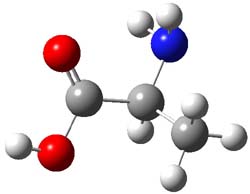Small energy differences pose a serious challenge for computation. The focal point analysis of Allen and Schaefer is one approach towards solving this problem, with energies extrapolated to the complete basis set limit at the HF and MP2 levels, and then corrections added on for higher-order effects.
These authors have applied the method to the conformations of alanine (similar to their previous study on cysteine – see this post).1 There are two low energy conformers 1 and 2. The CCSD(T)/cc-pVTZ structures are shown in Figure 1. The HF/CBS estimate places 2 below 1, but this is reveres at MP2. With the correction for CCSD and CCSD(T), and core electrons, the energy gap is only 0.45 kJ mol-1, favoring 1. Zero-point vibrational energy favors 1 by 1.66 kJ mol-1, for a prediction that 1 is 2.11 kJ mol-1 lower in energy than 2. It is interesting that most of this energy difference arises from differences in their ZPVE.
|
1 |
2 |
Figure 1. CCSD(T)/cc-pVTZ optimized geometries of the two lowest energy conformations of alanine.
The article also discusses the structures of these to conformers, obtained through a combination of theoretical treatment and revisiting the limited experimental measurements.
References
(1) Jaeger, H. M.; Schaefer, H. F.; Demaison, J.; Csaszar, A. G.; Allen, W. D., "Lowest-Lying Conformers of Alanine: Pushing Theory to Ascertain Precise Energetics and Semiexperimental Re Structures," J. Chem. Theory Comput., 2010, 6, 3066-3078, DOI: 10.1021/ct1000236
InChIs
Alanine: InChI=1/C3H7NO2/c1-2(4)3(5)6/h2H,4H2,1H3,(H,5,6)/t2-/m0/s1/f/h5H
InChIKey=QNAYBMKLOCPYGJ-SNQCPAJUDI


